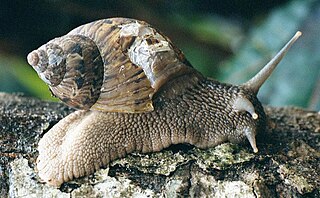
Helicidae is a large, diverse family of western Palaearctic, medium to large-sized, air-breathing land snails, sometimes called the "typical snails." It includes some of the largest European land snails, several species are common in anthropogenic habitats, and some became invasive on other continents. A number of species in this family are valued as food items, including Cornu aspersum the brown or garden snail, and Helix pomatia. The biologies of these two species in particular have been thoroughly studied and documented.

Clausiliidae, also known by the common name door snails, is a taxonomic family of small, very elongate, mostly left-handed, air-breathing land snails, sinistral terrestrial pulmonate gastropod mollusks.

Cochlodina is a genus of air-breathing land snails in the terrestrial pulmonate gastropod mollusk family Clausiliidae, the door snails.

The Orthalicoidea are a superfamily of air-breathing land snails, terrestrial gastropod mollusks in the infraorder Orthalicoidei of the suborder Helicina
Albinaria is a genus of air-breathing land snails, terrestrial pulmonate gastropod mollusks in the family Clausiliidae, the door snails.

Adolph Cornelis 'Dolf' van Bruggen was a Dutch malacologist, entomologist, and botanist. His interest in the tropics and tropical Africa has dominated his broad scientific interest for more than 50 years now. He was an expert especially in the land snail families Streptaxidae, Achatinidae and Maizaniidae. As of 2008, he had authored some 655 scientific publications.

Inchoatia haussknechti is a species of air-breathing land snail, a terrestrial pulmonate gastropod mollusk in the family Clausiliidae, the door snails.

Inchoatia megdova is a species of air-breathing land snail, terrestrial pulmonate gastropod mollusk in the family Clausiliidae, the door snails.

Inchoatia inchoata is a species of air-breathing land snail, a terrestrial pulmonate gastropod mollusc in the family Clausiliidae, the door snails.
Albinaria idaea is a species of air-breathing land snail, a terrestrial pulmonate gastropod mollusk in the family Clausiliidae, the door snails.








